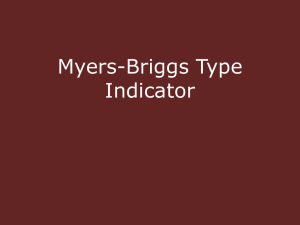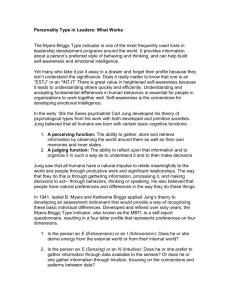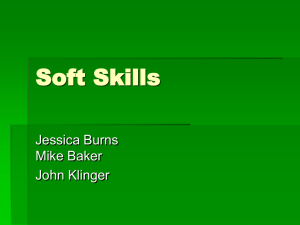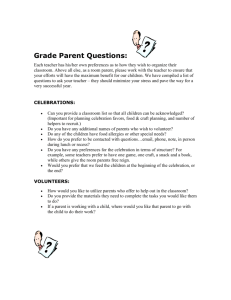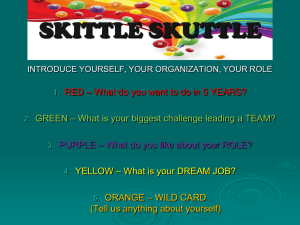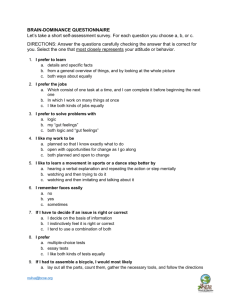Myers-Briggs Type Indicator
advertisement
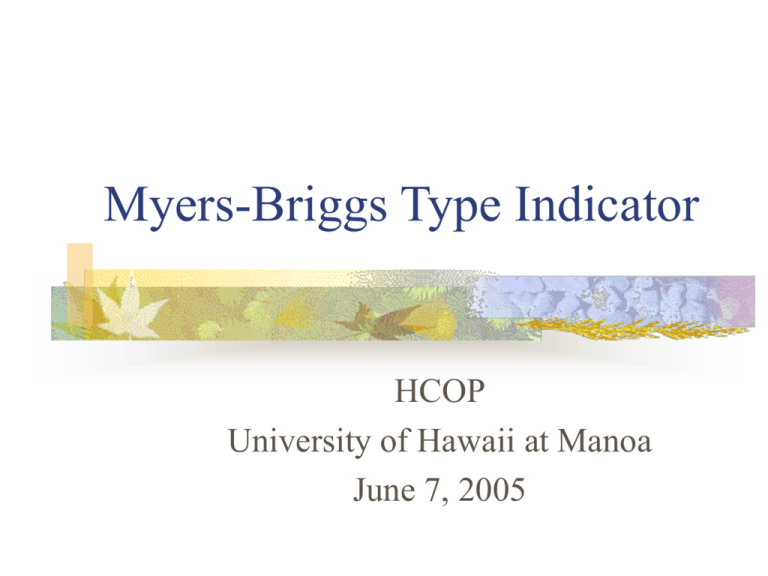
Myers-Briggs Type Indicator HCOP University of Hawaii at Manoa June 7, 2005 PURPOSE It identifies a person’s natural tendencies or preferred ways of doing things. It reports your preferences on four scales. Each scale represents two opposite preferences on a continuum. It is primarily concerned with the valuable differences in people that result from where they like to focus their attention, the way they like to take in information, the way they like to make decisions, and the kind of lifestyle they adopt. HISTORY/DEVELOPMENT Based on Jung’s typology. Modified and elaborated by Isabel Meyers and her mother, Katharine Briggs. Katharine become intrigued by the similarities and differences in human personality about the time of World War I and began to develop her own typology. She later discovered that Jung had developed a similar system. The sufferings and tragedies of the war stirred Meyer’s desire to do something that would help people understand each other and avoid destructive conflicts. This resulted in the creation of the “type indicator.” HISTORY/DEVELOPMENT Published forms have been in existence since 1956. Since 1975, over 30 million people have taken the Indicator. Today, the MBTI is one of the largest selling tools for self-awareness. It has been translated into more than 30 languages and is used to help people in career choices, marriage and family counseling, communication, leadership, learning, etc. WARM UP ACTIVITY: WRITING WITH YOUR DOMINANT AND NON-DOMINANT HAND •How did it feel? •Description of your writing? •Grade? TYPE VERFICATION AND BIAS CAN WE CHANGE OUR TYPE? Concepts for Understanding Type Verifying Your Type Preference VC C M S S M C VC E Extravert Introvert I Directing energy toward the outer world of people & objects Directing energy toward the inner world of experience & ideas VC C M S S M C VC S Sensing Intuition N Focusing on what can be perceived by the five senses Focusing on perceiving patterns & relationships Concepts for Understanding Type Verifying Your Type Preference VC C M S S M C VC T Thinking Feeling F Decisions based on logical analysis with objectivity & detachment Decisions based on personal or social values with understanding & harmony VC C M S S M C VC J Judgment Perception P Prefer a planned, decisive, orderly way of life Prefer a flexible, spontaneous way of life 16 Myers-Briggs Types ISTJ ISFJ INFJ INTJ ISTP ISFP INFP INTP ESTP ESFP ENFP ENTP ESTJ ESFJ ENFJ ENTJ Preference Clarity Dichotomy Greatest Raw Pts. Preferences Clarity Category E-I 11-13 14-16 17-19 20-21 Slight Moderate Clear Very Clear Preference Clarity Dichotomy Greatest Raw Pts. Preferences Clarity Category S-N 13-15 16-20 21-24 25-26 Slight Moderate Clear Very Clear Preference Clarity Dichotomy Greatest Raw Pts. Preferences Clarity Category T-F 12-14 15-18 19-22 23-24 Slight Moderate Clear Very Clear Preference Clarity Dichotomy Greatest Raw Pts. Preferences Clarity Category J-P 11-13 14-16 17-20 21-22 Slight Moderate Clear Very Clear TYPE DESCRIPTIONS THEORY OF TYPE DYNAMICS Dominant = favorite process; best developed Auxiliary = second best developed Tertiary = developed somewhat Inferior/shadow = least developed Dominant - directs our overall functioning; more dependable, have more confidence in it; rely on it for our best functioning. Dominant and auxiliary balance and complement each other - one is used to supply you with information and the other to make decisions based on that information. THEORY OF TYPE DYNAMICS Dominant and auxiliary functions are used differently by Es and Is. Es - dominant used in the outer world and auxiliary used in the inner world. Is - dominant used in the inner world and auxiliary used in the outer world. Inferior function is the opposite of the dominant function THEORY OF TYPE DYNAMICS E attitudes or orientations I S the perceiving functions N T the judging functions F J attitudes or orientations P ACTIVITY: DOMINANT- TYPE ALIKE GROUP “WHAT IS GREAT ABOUT US?” COPING UNDER STRESS “Emergence of the Shadow” “Use of my Shadow” MBTI AND LEARNING “What learning activities have you enjoyed/facilitated your learning?” “What learning environments have you preferred?” “What learning activities/situations have you disliked/impeded your learning?” “What learning environments have you disliked?” Learning and Personal Preferences EXTRAVERTS Enjoy talking, movement, action learning Enjoy cooperative projects Readily share & speak in class Can “talk on their feet” Want to experience things to really understand them More “trial and error” Need to plan more before leaping into projects INTROVERTS Need advance notice to think, plan, & rehearse before sharing ideas Enjoy solitary reading & writing Teacher-centered; lecture Can work for long periods on one project/task May spend too much time thinking about an assignment before doing it. Need to leap in sometimes without thinking so much Learning and Personal Preferences SENSING Types Learn best in step-by-step progression Prefer “hands-on” experience Value practical application of knowledge Excel in memorizing facts; can practice without variation Enjoy structured classes Are good with details & predictable routines Master facts and details; then “big picture” INTUITIVE Types Prefer concepts to discrete facts Excel at imaginative tasks; less patient with routines Tend to avoid or overlook details Readily grasp words & symbols Need to know the overview (“BIG picture”) first, then fill in facts and details Learning and Personal Preference THINKING Types Need logical rationales for projects Are more truthful than tactful Value fairness more than harmony Are able to be objective Contribute intellectual criticism Take facts, theories, & ideas more seriously Content may be more important than audience Clear criteria and teacher feedback are important FEELING Types Need personal encouragement; the human angle is important Allow feelings to override logic & objectivity May suppress own needs & ideas to keep harmony Are able to be empathetic Dislike expressing opinions that differ from those of peers Have difficulty being brief & businesslike Need to see how material can support personal value system Learning and Personal Preferences JUDGING Types May finish quickly but may miss new & valuable information Are good managers of time but could be too rigid Naturally plan & organize work; make and complete tasks Are decisive organized planners Enjoy closure, results, & products; good at completing tasks Prefer structured learning environment; clear objectives, deadlines Gauge learning by completion of tasks PERCEIVING Types May be so open to new information that completion is delayed Are flexible & curious but may tend to procrastinate May complete work in a last minute flurry of activity May make lists; may or may not complete them Are willing to “improvise” & change procedures Prefer freedom to explore within broad limits Feel imprisoned in highly structured classroom Need to prioritize and improve decision-making skills MBTI and Learning INTROVERSION- brings periods of reflection & contemplation needed for seeing associations & relationships between facts & concepts. EXTRAVERSION- brings an opportunity to verify learning. INTUITIVE skills- bring an awareness of the connections between facts & concepts, & allow deductive reasoning. SENSING skills- help to provide enough facts to think with. MBTI and Learning THINKING skills- bring a logical order to facts & concepts, thus adding memory. FEELING skills- can provide motivation to help maintain long-range perspective & to determine why the learning is important. JUDGING skills- bring the discipline & organization needed for effective time management. PERCEIVING skills- keep an openness to new potentially valuable information. Your type has potential strengths: Develop your type + balance it by learning skills of your opposites Type does not describe limitations on your thinking: Tells you what kinds of learning will be harder and easier - you can’t CHANGE type but you can LEARN SKILLS. “It’s not what type you are that’s important, it’s what you do with your type.” “Type doesn’t confine you to act or or learn in a certain way, but it frees you to draw on your strengths of your preferences and to strengthen your ability to use those opposite to yours” = TYPE DEVELOPMENT Type is like walking on a tightrope . . . If you’re going to make any progress, you have to work at keeping your balance. The scene is The Empire Strikes Back when Yoda levitates Luke Skywalker’s spaceship after Luke has tried and failed . . . Luke says, “I don’t believe it!” and Yoda replies, “That is why you failed.” SPAM MUSUBI
